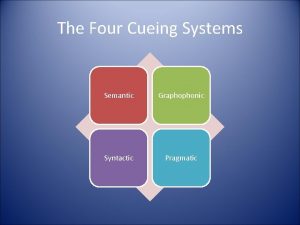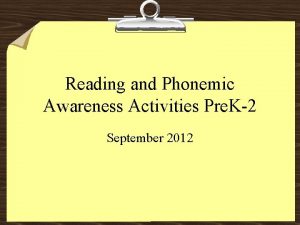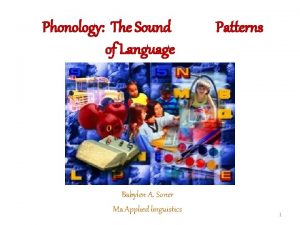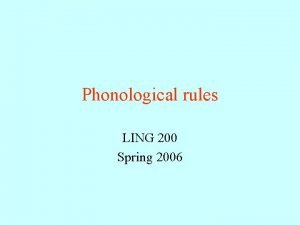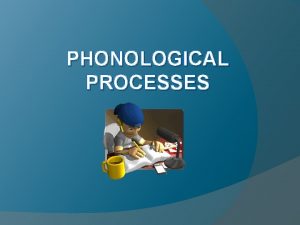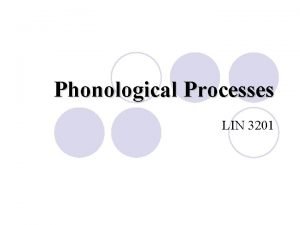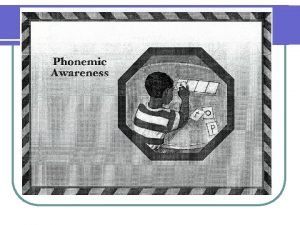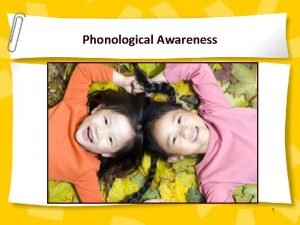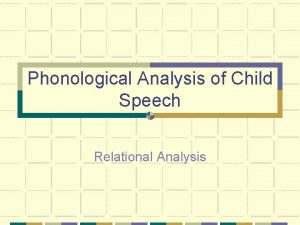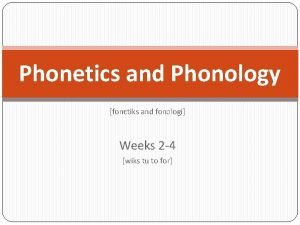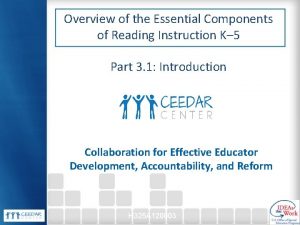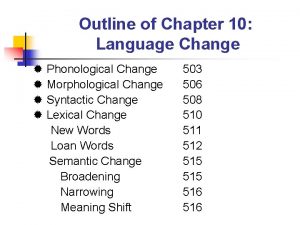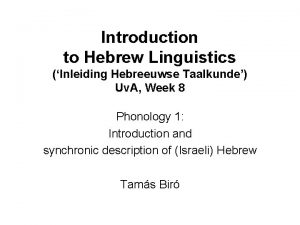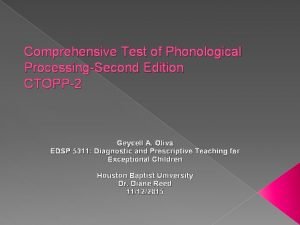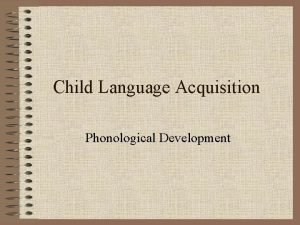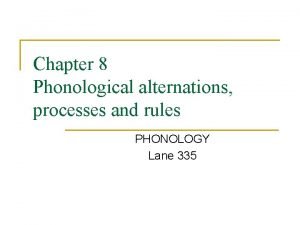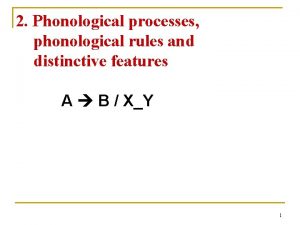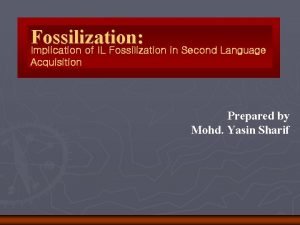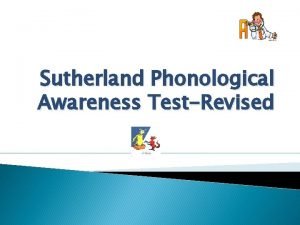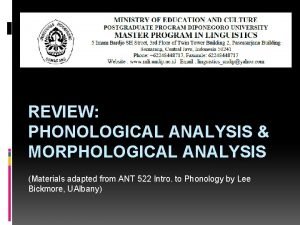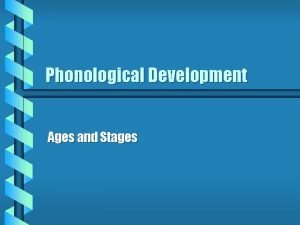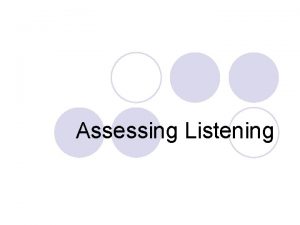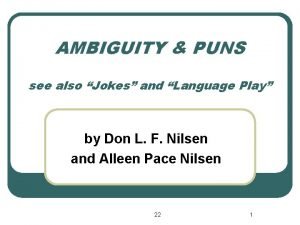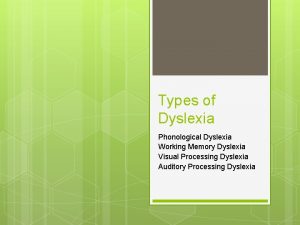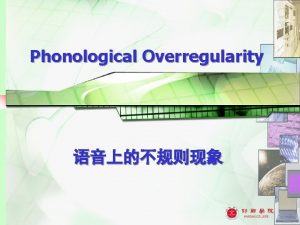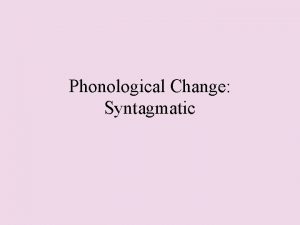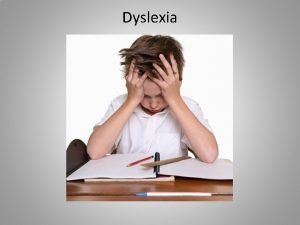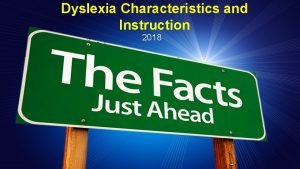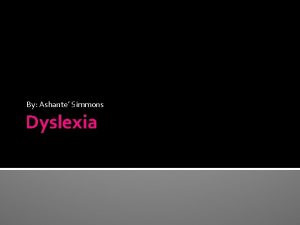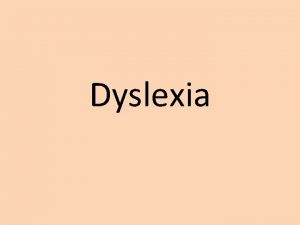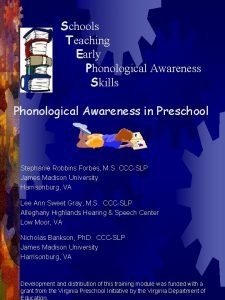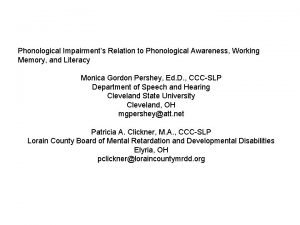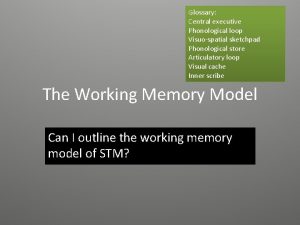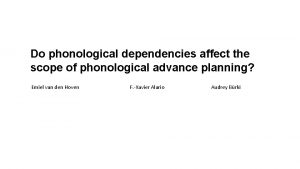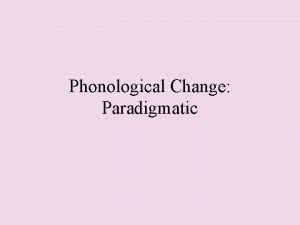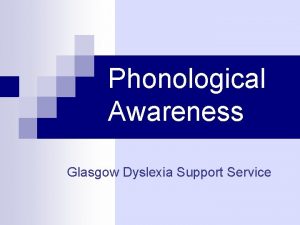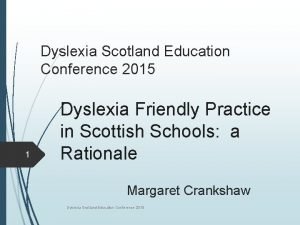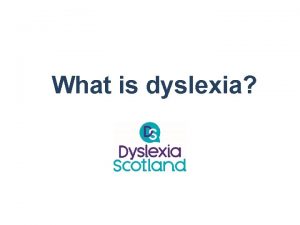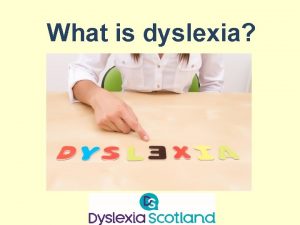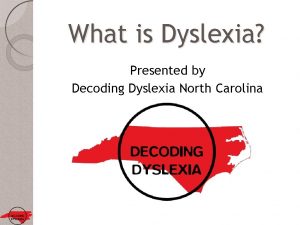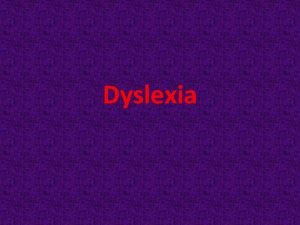Phonological dyslexia n n n Introduction Phonological dyslexia


























- Slides: 26

Phonological dyslexia n n n Introduction Phonological dyslexia was first described by Beauvois and Derouesne (1979); other early case are in Shallice and Warrington (1980), Patterson (1982) and Funnell (1983). A number of other studies of phonological dyslexia have appeared since then, and one issue of the journal Cognitive Neuropsychology in 1996 is a Special Issue devoted entirely to this particular acquired dyslexia. Phonological dyslexia also occurs as a form of developmental dyslexia i. e. as a specific pattern of difficulty in learning to read, in children without any sign of neurological abnormality.

The symptoms of phonological dyslexia. n The central symptom here is that nonword reading is much worse than word reading. Only in the case reported by Funnell (1983) was nonword reading completely abolished. In all other reported cases, some nonwords could be read. Also, there are no reported cases of phonological dyslexia where word reading is 100% correct. So the disorder is relative rather than absolute.









Dislessia fonologica

Esempi di errori nella lettura di non-parole H. M. J. E.

lettura di una lista bilanciata di parole/non parole non-parole

H. M. J. E.

J. E. H. M.

H. M. Among animals the fox has no rival for cunning. Suspicious of man, who is its only natural enemy, it will, when pursued, perform extraordinary feats, even alighting on the backs of sheeps to divert its scent trail. “Amongst animals the fox has no rivals for cunning. Surprisingly of man, who is its only natural enemy at will, with pursued performance extraordinary feat_, even alighting on the backs of sheep to divert its scent trial. ”

J. E. Each April, at the reapperence of the cuckoo in its familiar haunts, bird-watchers must marvel at the accurate flights with which birds span the distances between their seasonal abodies. “Each April, at the reapperence of the cuckoo in its familiar haunts, the bird-watchers must marvel at the accent flights with which the birds span the distance_ between the_ seasonal abodies. ”

The symptoms of phonological dyslexia. n n In deep dyslexia, nonword reading is also impaired relative to word reading, so the question arises as to whether phonological and deep dyslexia are really two different syndromes. A strong line that could be taken is that they are distinct syndromes, because phonological dyslexics do not make semantic errors in reading aloud, and because nonword reading is always completely abolished in deep dyslexia but very rarely abolished in phonological dyslexia. However, some of the other symptoms of deep dyslexia are seen in some but not all phonological dyslexics. For example, some phonological dyslexics are worse at reading abstract words than concrete words (true for all deep dyslexics); and some phonological dyslexics are worse at reading function (grammatical) words than content words (true for all deep dyslexics). So the boundary between the two conditions does look rather fuzzy.

The symptoms of phonological dyslexia. n n This is not really a problem for the cognitive neuropsychology of reading, which does not attempt to categorize patients into syndromes. And it is not really a problem for the clinician, since when a patient is observed with a selective difficulty in nonword reading, then * If semantic errors in word reading are present, and nonword reading is zero, call the patient a deep dyslexic; * If there are no semantic errors in word reading, and nonword reading is impaired but is not at zero, call the patient a phonological dyslexic. * Lastly, if semantic errors in word reading are present but nonword reading is not at zero, or if there are no semantic errors in word reading but nonword reading is at zero, call me - both of these patterns are important and need research!

The theoretical interpretation of phonological dyslexia n It is obvious that phonological dyslexia can be interpreted as due to a specific impairment of the non-lexical reading route of the model - the route that goes from abstract letter identification through letter-to-sound rules to phonological output buffer. Damage at any stage along that route will impair the ability to read nonwords. Even when there is such damage, word reading will still be possible, because the lexical reading route can still be used.

Phonological dyslexia n Phonological dyslexia: if brain damage has affected knowledge of letter-to-sound rules, this won't affect the ability to read aloud words, but will make the reading of nonwords such as vip or ob inaccurate.

The theoretical interpretation of phonological dyslexia n Different locations of the damage to the nonlexical reading route will give rise to different forms of phonological dyslexia. For example (see Coltheart, 1985), some patients may be impaired in the ability to break a letter-string up into its graphemes (a grapheme is a letter or letter string that represents an individual speech sound or phoneme - e. g. the string SHOOF has the three graphemes SH, OO, and F). Others may be able to do this but have difficulty in assigning the right phonemes to these graphemes. And others may be able to carry out both of these operations but have difficulty in blending together a sequence of phonemes into an integrated pronunciation,

Word visual analysis parser word detectors (input logogens) semantic system Phonological word representations (output logogens) response buffer “Word” translator retranslate blender

Developmental phonological dyslexia n Temple and Marshall (1983) described a case of developmental phonological dyslexia, and Castles and Coltheart (1994) have shown that this form of developmental dyslexia is not uncommon. These are children who have specific trouble with the phonic side of reading - that is, in learning to sound out words by letter-sound rules. They can have much less trouble with the lexical side of learning to read i. e. in developing their sight vocabularies.

Treatment n There have been no studies of the treatment of acquired phonological dyslexia, but it seems highly likely that it is treatable, since in the much more severe condition of deep dyslexia it is possible, with intensive remediation, to restore the ability to read nonwords aloud, even when it was completely abolished by brain damage; see deep dyslexia.

References n Beauvois, M. F. , & and Derouesne, J. (1979) Phonological alexia: three dissociations. Journal of Neurology, Neurosurgery and Psychiatry, 42, 1115 -1124. n Castles, A. and Coltheart, M. Varieties of developmental dyslexia. Cognition, 1993, 47, 149 -180. n Coltheart, M. Varieties of developmental dyslexia. Cognition, 1987, 27, 97 -101. n n n Coltheart, M. (Ed. ), Phonological Dyslexia. Hove: Lawrence Erlbaum Associates, 1996. A special issue of the jourrnal Cognitive Neuropsychology (1996, September). Coltheart, M. (1985) Cognitive neuropsychology and the study of reading. In Posner, M. I and Marin, O. S. M (Eds) Attention and Performance XI. London: Lawrence Erlbaum Associates. Funnell, E. (1983) Phonological processes in reading: New evidence from acquired dyslexia. British Journal of Psychology, 74, 159 -180. Patterson, K. (1982) The relation between reading and phonological coding: Further neuropsychological observations. In Ellis, A. W. (Ed), Normality and Pathology in Cognitive Functions. London: Academic Press. Shallice, T. and Warrington, E. K. (1980) Single and multiple component central dyslexic syndromes. In Coltheart, M. , Patterson, K. , and Marshall, J. C. (Eds. ), Deep Dyslexia. London: Routledge and Kegan Paul Temple, C. M. , & Marshall, J. C. (1983). A case study of developmental phonological dyslexia. British Journal of Psychology, 74, 517 -533.
 Phonological ambiguity examples
Phonological ambiguity examples Syntactic cues in reading
Syntactic cues in reading Central executive
Central executive Why is phonological awareness important
Why is phonological awareness important Phonological loop
Phonological loop Phonology examples
Phonology examples Phonology questions
Phonology questions Phonological rule
Phonological rule Morphonemics
Morphonemics Assimilation rules in phonology
Assimilation rules in phonology Phonological awareness
Phonological awareness Phonemic awareness continuum
Phonemic awareness continuum Phonological process analysis
Phonological process analysis Labidental
Labidental Phonological continuum
Phonological continuum Phonological change examples
Phonological change examples Proto semitic
Proto semitic Ctopp-2 percentile ranks
Ctopp-2 percentile ranks Phonological development in child language acquisition
Phonological development in child language acquisition Phonological alternation examples
Phonological alternation examples Dentalization phonological process
Dentalization phonological process Language fossilization definition
Language fossilization definition Sutherland phonological awareness test
Sutherland phonological awareness test Phonological analysis example
Phonological analysis example Phonological development stages
Phonological development stages Recognizing phonological and morphological elements
Recognizing phonological and morphological elements Ambiguous joke
Ambiguous joke

